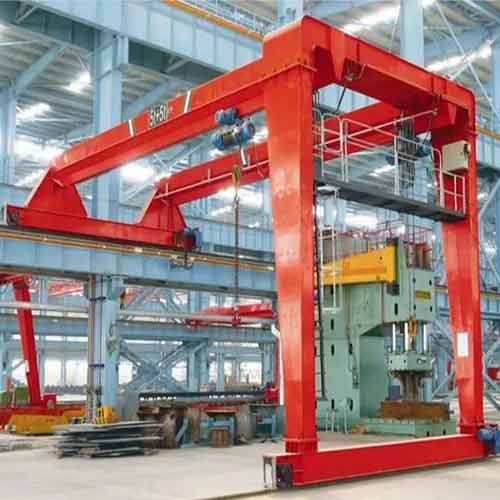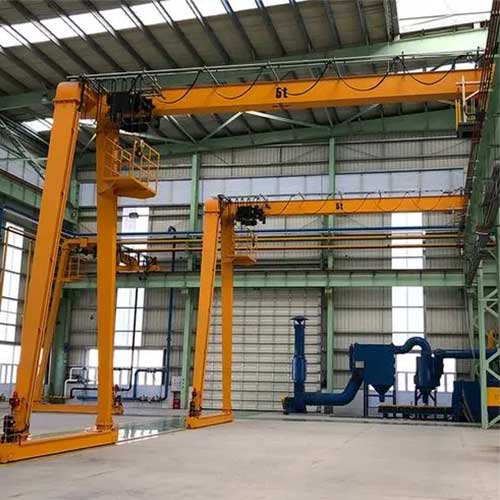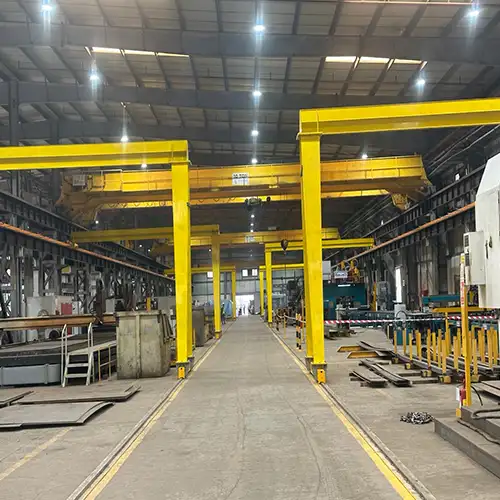Single Girder & Double Girder Semi Gantry Crane for Sale Good Price
Semi gantry crane for sale. Check single girder semi gantry crane & double girder semi gantry crane comparison to get right type of semi gantry crane for you.
Category: Full& Half Gantry
Your Trusted Semi Gantry Crane Manufacturer & Supplier
Single-Girder Semi Gantry Cranes & Double-Girder Semi Gantry Cranes
A Comprehensive Guide for Buyers on Single Grider & Double Girder Semi Gantry Crane
Gantry cranes are a crucial asset in the world of material handling, enabling the efficient movement of heavy loads in various industries. Among the diverse range of gantry cranes available, semi gantry cranes stand out as versatile solutions that combine the benefits of traditional overhead gantry cranes and mobile crane systems. In this comprehensive guide for buyers, we will explore the world of semi gantry cranes, with a particular focus on single-girder and double-girder configurations.
Semi gantry cranes, sometimes referred to as half gantry cranes, are a subset of gantry cranes known for their unique design. These cranes are characterized by having one end supported by a vertical column or leg, while the other end runs on a set of wheels or casters along a rail or track. This configuration allows semi gantry cranes to operate in a linear path while providing the advantage of mobility on one side.
The primary purpose of semi gantry cranes is to lift, transport, and position heavy loads within a specified workspace. They are especially useful in scenarios where a full gantry crane installation may not be practical or where mobility is a key requirement. Semi gantry cranes strike a balance between the stability and lifting capacity of traditional gantry cranes and the portability of mobile cranes.
Semi Gantry Crane For Sale
Semi gantry crane is a piece of gantry lifting equipment used indoors and outdoors, such as machine shop, warehouse and freight yard. It is also regarded as a combination of half overhead crane and half gantry crane in that it is mounted to a carriage that travels on an overhead runway on one side and supported by a leg that travels along rails on the ground on the other side.
Designed for general purpose, this type of crane can be used for small to heavy duty lifting work in manufacturing and material handling industries. The cranes supplied by our company are also available in custom design to meet your special requirements.
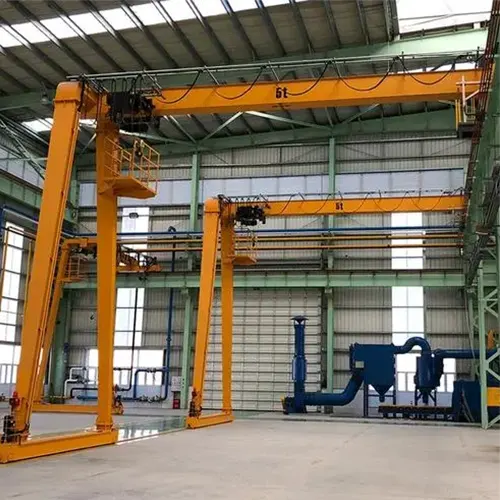
BMH single girder semi gantry crane parameters:
- Load capacity: 3-20t
- Span: 8-30m
- Lifting height: 6-18m
- Lifting speed: 0.33-8m/min
- Trolley running speed: 20m/min
- Crane running speed: 20m/min
- Work duty: A3-A4
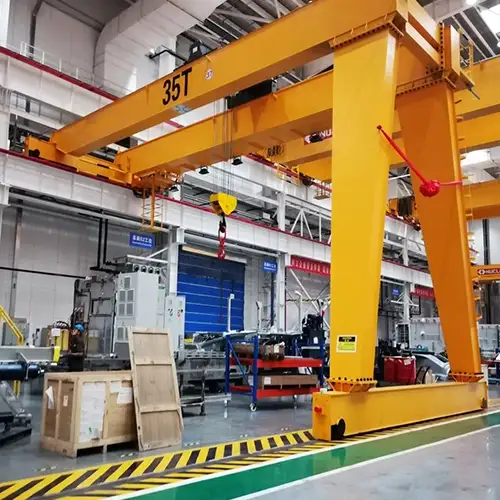
BMG double girder semi gantry crane parameters:
- Load capacity: 5-32t
- Span: 12-30m
- Lifting height: 6-12m
- Lifting speed: 6-11.5m/min
- Trolley running speed: 37-40.1m/min
- Crane running speed: 37.7-40.1m/min
- Work duty: A3-A6
| Technical Parameter of BMH Electric Hoist Semi Gantry Crane | ||||||
| Capacity | t | 3 | 5 | 10 | 16 | 20 |
| Span | S(m) | 8~30 | 8~30 | 8~30 | 8~30 | 8~30 |
| Lifting height | m | 6~18 | 6~18 | 6~18 | 6~18 | 6~18 |
| Lifting speed | m/min | 8(0.8/8) | 8(0.8/8) | 7(0.7/7) | 3.5(0.35/3.5) | 3.3(0.33/3.3) |
| Trolley speed | m/min | 20(30) | 20(30) | 20(30) | 18 | 14 |
| Crane speed | m/min | 20(30) | 20(30) | 20(30) | 20(30) | 20(30) |
| Work duty | A3~A4 | A3~A4 | A3~A4 | A3~A4 | A3~A4 | |
| Track type | P24 | P24 P30 | P30 P38 | P30 P38 | P38 P43 |
| Technical Parameter of BMG Double Girder Semi Gantry Crane | ||||||
| Capacity | t | 5 | 10 | 16 | 20 | 32 |
| Span | S(m) | 12~30 | 12~30 | 12~30 | 12~30 | 12~30 |
| Lifting height | m | 6~12 | 6~12 | 6~12 | 6~12 | 6~12 |
| Lifting speed | m/min | 11.5 | 8.5 | 7.9 | 7.2 | 6 |
| Trolley speed | m/min | 37.2 | 37.4 | 40.1 | 40 | 37 |
| Crane speed | m/min | 37.7 | 37.7 | 40.1 | 40.1 | 38 |
| Work duty | A3~A6 | A3~A6 | A3~A6 | A3~A6 | A3~A6 | |
| Track type | P43 | P43 | P43 QU70 | P43 QU70 | P50 QU80 |
Differentiating Between Single-Girder and Double-Girder Configurations
Semi gantry cranes come in two main configurations: single-girder and double-girder. The key differentiator between these two configurations is the number of horizontal beams or girders used to support the lifting mechanism:
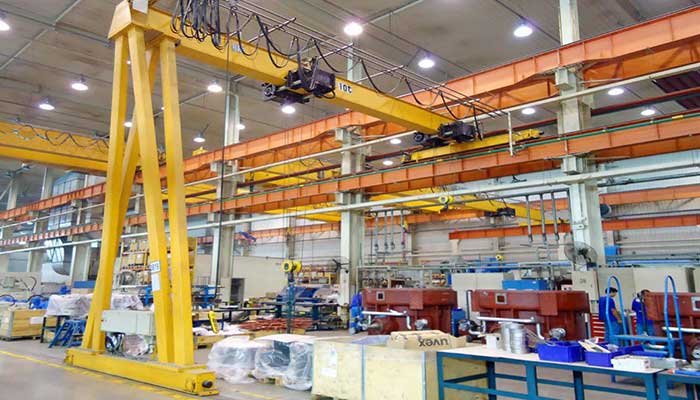
Single-Girder Semi Gantry Cranes:
These cranes have a single horizontal beam that spans the width of the crane. The lifting mechanism, typically a hoist or trolley, is attached to this single girder. Single-girder semi gantry cranes are known for their simplicity, cost-effectiveness, and suitability for lighter lifting tasks.
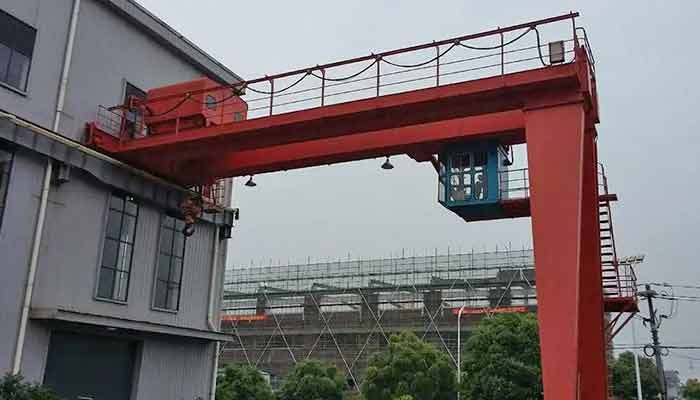
Double-Girder Semi Gantry Cranes:
In contrast, double-girder semi gantry cranes feature two parallel horizontal beams or girders that provide enhanced stability and lifting capacity. These cranes are designed for heavy-duty applications and can handle significantly larger loads.
When it comes to material handling, semi gantry cranes are versatile workhorses that offer a unique combination of features. To make an informed buying decision, it's crucial to delve into their design, functions, and key components.
Overview of Semi Gantry Crane Design and Function
At its core, a semi gantry crane is designed to straddle a workspace while having one end supported by a vertical column or leg, and the other end equipped with wheels or casters that move along a rail or track. This design allows the crane to move horizontally in a linear path, providing mobility on one side, and lift and lower loads with precision.
Key Components and Features
Understanding the key components and features of semi gantry cranes is essential for assessing their suitability for your specific material handling needs:
- Vertical Column or Leg: The vertical column or leg is the fixed support structure of the crane. It provides stability and structural integrity to the entire system. The design of this support structure can vary based on the specific requirements of the crane.
- Horizontal Beam or Girder: The horizontal beam or girder, which can be a single or double beam, serves as the primary horizontal structure of the crane. It supports the lifting mechanism and distributes the load evenly.
- Lifting Mechanism: The lifting mechanism of a semi gantry crane typically includes a hoist or a trolley with a hook, chain, or other lifting attachments. This component is responsible for raising, lowering, and moving the load horizontally.
- Wheels or Casters: The mobile end of the crane is equipped with wheels or casters that allow it to move along a rail or track. These wheels are often designed to ensure smooth and precise movement.
- Control System: A control system, which can be manual or automated, is used to operate the crane. It includes controls for lifting, lowering, and moving the crane along its path. Advanced systems may also include safety features and remote control options.
- Safety Features: Safety is paramount in crane operations. Semi gantry cranes are equipped with various safety features such as overload protection, emergency stop buttons, limit switches, and safety interlocks to ensure the safe handling of heavy loads.
- Customization Options: Semi gantry cranes can be customized to meet specific lifting requirements. Customization options may include different types of hooks, spreader bars, clamps, and lifting attachments tailored to the materials being handled.
- Portability: One of the defining features of semi gantry cranes is their mobility. This allows for flexibility in positioning the crane as needed within a facility. Portability is a significant advantage, particularly for single-girder semi gantry cranes.
By understanding these components and features, you gain insight into the functionality and adaptability of semi gantry cranes. Whether you opt for a single-girder or double-girder configuration, this knowledge will help you make an informed decision when selecting the ideal crane for your material handling tasks.
Advantages and Limitations of Semi Gantry Cranes
Before making a purchase decision, it's essential to weigh the advantages and limitations of semi gantry cranes to ensure they align with your material handling requirements. Let's explore these aspects:
Advantages of Semi Gantry Cranes
- Mobility and Versatility: Perhaps the most significant advantage of semi gantry cranes is their mobility. The mobile end with wheels or casters allows for easy relocation within a facility, making them suitable for tasks that require flexibility in positioning.
- Space Efficiency: Semi gantry cranes are space-efficient, especially in settings with limited overhead clearance. Their ability to straddle a workspace while having one fixed support leg minimizes the space they occupy.
- Cost-Effective: Compared to full gantry cranes or bridge cranes, semi gantry cranes are often more cost-effective. They provide a balance between the capabilities of traditional gantry cranes and mobile cranes at a lower price point.
- Precision Handling: Semi gantry cranes offer precise control over load movement, making them suitable for tasks that require careful positioning and placement of heavy objects.
- Safety Features: These cranes are equipped with essential safety features, including overload protection, emergency stop buttons, and safety interlocks, ensuring secure load handling.
- Customization Options: Semi gantry cranes can be customized with various lifting attachments and accessories to meet specific material handling needs, enhancing their versatility.
Limitations and Considerations
- Lifting Capacity: Semi gantry cranes have limitations on their lifting capacity compared to full gantry cranes or overhead bridge cranes. While suitable for many tasks, they may not be suitable for extremely heavy loads.
- Span Limitations: The span or reach of semi gantry cranes is limited by the length of the horizontal beam or girder. This limitation may affect their suitability for tasks that require a more extensive span.
- Foundation Requirements: The fixed support leg of semi gantry cranes requires a stable and strong foundation. This consideration is especially important for double-girder semi gantry cranes.
- Terrain and Flooring: The mobility of semi gantry cranes relies on the quality of the flooring or track on which the wheels or casters move. Uneven or rough terrain can impact their performance.
- Heavy-Duty Applications: While suitable for a wide range of applications, semi gantry cranes may not be the best choice for extremely heavy-duty tasks, such as those found in industries like steel production or shipbuilding.
- Permanent vs. Temporary Use: Consider whether the crane is needed for permanent installation or temporary use. Single-girder semi gantry cranes are more portable and well-suited for temporary applications, while double-girder cranes are often installed permanently.
By carefully assessing these advantages and limitations, you can determine whether a semi gantry crane is the right fit for your material handling needs. Your specific application, load requirements, available space, and budget will play a crucial role in making an informed decision.
Determining Your Lifting Needs
Before investing in a semi gantry crane, it's essential to thoroughly analyze your material handling requirements. This involves assessing factors such as load capacity, span, and lift height to ensure that the crane you choose aligns perfectly with your specific needs.
Analyzing Your Material Handling Requirements
- Nature of Materials: Start by identifying the types of materials or objects you need to lift and move. Consider factors like size, shape, weight, and any special handling requirements.
- Frequency of Use: Determine how often you'll be using the crane. Will it be for occasional tasks or continuous, daily operations? This impacts the durability and maintenance needs of the crane.
- Workspace Layout: Examine your workspace and layout. Are there any obstacles, confined spaces, or specific areas where the crane needs to operate? Consider how the crane's mobility will fit within your facility.
- Operational Environment: Assess the environmental conditions where the crane will operate. This includes factors like temperature, humidity, and the presence of dust, chemicals, or corrosive substances.
- Precision Requirements: Determine whether your material handling tasks require precise positioning and placement of loads. This influences the control system and accessories you may need.
Load Capacity, Span, and Lift Height Considerations
- Load Capacity: Establish the maximum weight that the crane will need to lift. Ensure that the crane's lifting capacity comfortably exceeds the heaviest load you anticipate handling. Keep in mind that single-girder and double-girder semi gantry cranes have different weight limits.
- Span Length: Measure the distance or span over which the crane will need to travel. Ensure that the crane's horizontal beam or girder is long enough to cover this span. For larger spans, a double-girder crane may be more suitable.
- Lift Height: Determine the maximum height to which the crane will need to lift loads. Consider any overhead obstacles or height restrictions in your workspace. The lift height may be limited by the crane's design.
- Load Distribution: Assess how the load will be distributed across the crane's lifting attachments. Ensure that the load is balanced and properly secured to prevent accidents or damage.
- Future Growth: Consider whether your material handling needs are likely to change or grow in the future. Investing in a crane that accommodates potential future requirements can save you from costly upgrades later.
- Budget: Establish a budget for your crane purchase, including installation, accessories, and any necessary modifications to your workspace.
By thoroughly analyzing your material handling requirements and taking load capacity, span, and lift height considerations into account, you can pinpoint the precise specifications that your semi gantry crane should meet. This proactive approach ensures that the crane you select aligns perfectly with your operational needs and helps you make a well-informed buying decision.
Single-Girder Semi Gantry Cranes: In-Depth Analysis
Single-girder semi gantry cranes are versatile lifting solutions with specific features, benefits, and considerations. In this section, we'll dive deeper into their characteristics, applications, structural aspects, and cost considerations.

European style single girder semi gantry crane for indoor use
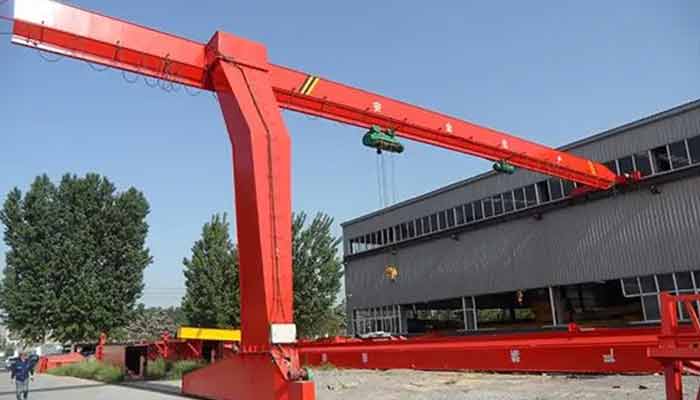
Chinese styel single girder semi gantry crane for outdoor use
Features and Benefits
- Simplicity: Single-girder semi gantry cranes feature a straightforward design with a single horizontal beam that spans the width of the crane. This simplicity makes them easy to operate and maintain.
- Cost-Effective: These cranes are often more budget-friendly compared to double-girder cranes. They provide a cost-effective solution for various material handling tasks.
- Mobility: Single-girder semi gantry cranes excel in mobility. The mobile end with wheels or casters allows for easy relocation within your facility, making them suitable for tasks that require flexibility.
- Space Efficiency: Their compact design makes them ideal for applications with limited overhead clearance. They occupy less space while offering stability and lifting capacity.
- Versatility: Single-girder semi gantry cranes are adaptable to a wide range of industries and tasks. Their mobility and flexibility make them suitable for various material handling operations.
Typical Applications
Single-girder semi gantry cranes find utility in numerous applications, including:
- Warehouses and Distribution Centers: They assist in loading and unloading goods, stacking materials on shelves or racks, and optimizing storage space.
- Manufacturing and Assembly Lines: These cranes play a pivotal role in manufacturing plants, aiding in the movement of raw materials, parts, and finished products along assembly lines.
- Construction and Building Sites: On construction sites, they are indispensable for lifting heavy construction materials, steel beams, concrete blocks, and other building components.
- Maintenance and Repair Operations: In various industries, single-girder semi gantry cranes are instrumental in positioning heavy machinery, lifting and placing components, and conducting routine maintenance on equipment.
- Emergency Services: Portable single-girder semi gantry cranes are invaluable tools for rescue and recovery operations, capable of lifting and stabilizing heavy objects during critical moments.
Structural Considerations
- Foundation: Ensure that the fixed support leg of the crane is anchored to a stable and strong foundation. The quality of the foundation directly impacts the crane's stability and safety.
- Span and Height: Consider the span length (distance the crane needs to travel) and lift height (maximum height to which loads must be lifted) when choosing a single-girder semi gantry crane. These specifications should align with your material handling requirements.
Cost Considerations
- Initial Investment: Single-girder semi gantry cranes are generally more cost-effective than their double-girder counterparts. Their lower initial investment makes them an attractive option for businesses with budget constraints.
- Operating Costs: Consider ongoing operating costs, including maintenance, energy consumption, and any necessary safety upgrades or inspections.
- Return on Investment (ROI): Assess the potential ROI by evaluating how the crane's efficiency and productivity improvements can positively impact your business operations.
Understanding the features, benefits, typical applications, structural considerations, and cost factors associated with single-girder semi gantry cranes will assist you in determining whether they are the right choice for your material handling needs. This knowledge will guide you in making a well-informed decision that aligns with your operational requirements and budget constraints.
Double Girder Semi Gantry Cranes: In-Depth Analysis
Double girder semi gantry cranes are essential pieces of heavy machinery used in various industries to lift and move heavy loads within a workspace. They offer a unique combination of the characteristics of both gantry cranes and overhead bridge cranes, making them versatile and adaptable to a range of applications. This in-depth analysis provides an overview of double girder semi gantry cranes, their components, applications, advantages, and considerations.
Double girder semi gantry cranes consist of two horizontal girders supported by legs or columns, with one end of the girders connected to a runway beam attached to a wall or structural support, while the other end moves on wheels or rails. This design allows for effective lifting and horizontal movement of heavy loads.
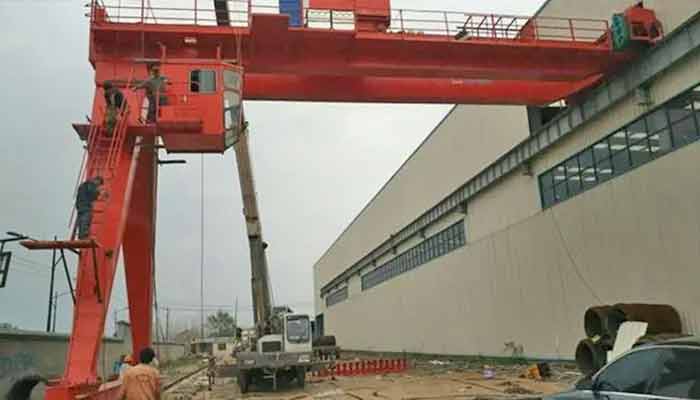
Double girder semi gantry crane for outdoor use

Double girder semi gantry crane for indoor use
Features and Benefits:
Double girder semi gantry cranes offer a range of features and benefits that make them valuable in various industrial settings:
- High Load Capacity: These cranes are designed for heavy-duty lifting, making them suitable for applications that involve moving large and heavy loads.
- Versatility: They can be adapted to accommodate different types of lifting attachments, such as hooks, magnets, and grabs, allowing for a wide range of material handling tasks.
- Precise Positioning: The trolley system on the girders enables accurate positioning of loads, which is crucial in manufacturing and assembly processes.
- Safety Features: Many double girder semi gantry cranes are equipped with safety features like limit switches, emergency stop buttons, and overload protection systems to ensure safe operations.
- Durable Construction: They are built to withstand harsh industrial environments, with sturdy steel girders and robust components that provide longevity and reliability.
- Cost-Effective: These cranes can be a cost-effective solution for businesses, especially when considering their load capacity and versatility.
Typical Applications:
Double girder semi gantry cranes are employed in various industries and applications, including:
- Manufacturing and Assembly: They are used in assembly lines and production areas for lifting and positioning heavy components.
- Construction: These cranes assist in material handling on construction sites, moving items like steel beams and concrete blocks.
- Warehousing and Logistics: They are utilized in warehouses and distribution centers for efficient loading and unloading of goods.
- Marine and Ports: Double girder semi gantry cranes play a role in handling containers and cargo in marine terminals and ports.
- Aerospace: These cranes are essential in the aerospace industry for the precise handling of aircraft components.
Structural Considerations:
When planning to install a double girder semi gantry crane, several structural considerations must be taken into account:
- Span: The span refers to the distance between the crane's supporting legs or columns. It should match the layout of your workspace and the required coverage area.
- Height: The hook height, or the distance from the floor to the hook, is important to ensure that the crane can lift and maneuver loads within your facility without obstructions.
- Runway System: Proper support for the crane's girders is necessary, whether through columns, walls, or an overhead runway system.
- Foundation and Flooring: The foundation must be capable of supporting the crane's structure and load. Additionally, the flooring should be even and durable to accommodate the crane's movement.
Cost Considerations:
The cost of a double girder semi gantry crane can vary based on several factors:
- Load Capacity: Higher load capacity cranes typically come at a higher cost due to the need for robust components and structural support.
- Customization: Modifications and custom features, such as specific hoist mechanisms or control systems, can affect the overall cost.
- Installation and Maintenance: Consider the expenses associated with crane installation and ongoing maintenance to ensure safe and efficient operations.
- Operational Costs: Operating a crane may require electricity, and this ongoing expense should be considered in your budget.
- Total Cost of Ownership: Evaluate the long-term costs, including maintenance, repairs, and energy consumption, to make an informed decision.
Understanding these features, benefits, applications, structural considerations, and cost factors associated with double girder semi gantry cranes will help you determine whether they are the right choice for your material handling needs. It's crucial to align these considerations with your operational requirements and budget constraints for a well-informed decision.
Comparison of Single Girder and Double Girder Semi Gantry Cranes
Buyers often face a decision when selecting semi gantry cranes for their material handling needs. Understanding the advantages, benefits, and typical applications of both single girder and double girder semi gantry cranes is crucial to make an informed choice.
1. Load Capacity:
Single Girder Semi Gantry Crane:
Typically lower load capacity compared to double girder cranes.
Suitable for lighter to moderate loads.
Double Girder Semi Gantry Crane:
Offers higher load capacity.
Ideal for heavy and extra-heavy loads.
2. Height and Hook Coverage:
Single Girder Semi Gantry Crane:
Offers less hook height due to the single girder design.
Better suited for facilities with limited vertical space.
Double Girder Semi Gantry Crane:
Provides higher hook height for greater vertical clearance.
Suitable for applications where ample vertical space is required.
3. Price and Cost Efficiency:
Single Girder Semi Gantry Crane:
Generally more cost-effective in terms of upfront investment.
Ideal for businesses with budget constraints.
Double Girder Semi Gantry Crane:
Typically more expensive due to the heavier construction and higher load capacity.
Offers excellent value for handling heavy loads and demanding applications.
4. Versatility and Applications:
Single Girder Semi Gantry Crane:
Well-suited for light to moderate-duty applications.
Commonly used in manufacturing, assembly, and warehousing.
Double Girder Semi Gantry Crane:
Versatile for a wide range of applications, including heavy manufacturing, ports, and steel mills.
Ideal for heavy-duty tasks that require precision and reliability.
5. Precision and Stability:
Single Girder Semi Gantry Crane:
Provides stability and precision for most general material handling tasks.
Double Girder Semi Gantry Crane:
Offers enhanced stability, especially when dealing with heavy and irregularly shaped loads.
6. Space Optimization:
Single Girder Semi Gantry Crane:
Requires less space due to its lighter design.
Suitable for facilities with limited floor space.
Double Girder Semi Gantry Crane:
Requires more space but can span larger distances, making it ideal for covering a broader area.
7. Installation and Maintenance:
Single Girder Semi Gantry Crane:
Easier and less costly to install and maintain.
Faster setup.
Double Girder Semi Gantry Crane:
Installation may be more complex and expensive.
Requires more extensive maintenance due to the larger and heavier components.
8. Energy Consumption:
Single Girder Semi Gantry Crane:
Typically consumes less energy due to its smaller size and load capacity.
Double Girder Semi Gantry Crane:
May have higher energy consumption, especially for lifting heavy loads.
9. Long-Term Investment:
Single Girder Semi Gantry Crane:
Suitable for businesses with light to moderate material handling needs.
Offers a cost-effective solution for short to medium-term requirements.
Double Girder Semi Gantry Crane:
Ideal for businesses with long-term or heavy-duty material handling needs.
Provides durability and reliability in demanding environments.
In summary, the choice between single girder and double girder semi gantry cranes depends on specific operational requirements, budget constraints, and the nature of the materials being handled. Single girder cranes are more cost-effective for lighter loads and space-constrained environments, while double girder cranes excel in heavy-duty, precision-critical applications with ample vertical space. Buyers should carefully evaluate their needs and consider these factors to select the most suitable type of semi gantry crane.
Similarities:
- Gantry Structure: Both single girder and double girder semi gantry cranes have a gantry structure with one side supported by legs or columns and the other side moving on wheels or rails.
- Material Handling: Both types of cranes are used for lifting and transporting heavy loads within a workspace.
- Versatility: They can be adapted to accommodate different types of lifting attachments and can perform a wide range of material handling tasks.
- Safety Features: Both types of cranes are equipped with safety features to ensure safe operations, such as limit switches and overload protection.
- Durable Construction: They are built to withstand harsh industrial environments, featuring sturdy steel girders and robust components for longevity and reliability.
Differences:
| Aspect | Single Girder Semi Gantry Crane | Double Girder Semi Gantry Crane |
|---|---|---|
| Number of Girders | One | Two |
| Load Capacity | Lower (typically) | Higher (typically) |
| Hook Height | Limited range | Can have a greater range |
| Precise Positioning | Precise | More precise |
| Cost | Lower (typically) | Higher (typically) |
| Headroom | Requires less vertical space | Requires more vertical space |
| Structural Complexity | Simpler | More complex |
| Applications | Light to moderate-duty tasks | Heavy-duty tasks |
| Customization Options | Fewer options | More options |
Safety and Compliance
Ensuring the safety of personnel, equipment, and materials is paramount when operating semi gantry cranes. In this section, we'll explore safety standards, regulations, and the various safety features and options that contribute to safe crane operations.
Safety Standards and Regulations
- OSHA Regulations: The Occupational Safety and Health Administration (OSHA) in the United States sets strict regulations for crane safety. These regulations cover aspects such as operator training, inspection requirements, and load capacity limits.
- ASME Standards: The American Society of Mechanical Engineers (ASME) provides standards and guidelines for crane design, manufacturing, and operation. Compliance with ASME standards helps ensure the structural integrity and safety of cranes.
- Local Regulations: Depending on your location and industry, there may be additional local or industry-specific regulations that govern the use of cranes. It's crucial to be aware of and adhere to these regulations.
- International Standards: For global operations, consider international crane standards, such as those developed by the International Organization for Standardization (ISO), to ensure uniform safety practices across different regions.
Safety Features and Options
- Overload Protection: All semi gantry cranes should be equipped with overload protection systems that prevent the crane from lifting loads beyond its rated capacity. This feature helps prevent accidents due to overloading.
- Emergency Stop Buttons: Emergency stop buttons or switches should be readily accessible to crane operators. Pressing this button instantly halts crane movement in case of an emergency or unsafe conditions.
- Safety Interlocks: Safety interlocks ensure that specific operations, such as opening crane doors or activating certain functions, can only be performed when specific safety conditions are met, enhancing overall safety.
- Limit Switches: Limit switches are used to set upper and lower travel limits for the crane's movement. When these limits are reached, the crane automatically stops, preventing collisions and overextension.
- Anti-Collision Systems: In facilities with multiple cranes or potential collision hazards, anti-collision systems can be installed to monitor and prevent crane collisions, enhancing workplace safety.
- Warning Lights and Alarms: Visual and audible warning systems alert personnel to the crane's movements, especially during operation, preventing accidental entry into the crane's path.
- Remote Control: Some semi gantry cranes offer remote control options, allowing operators to maintain a safe distance from the load and the crane itself while maintaining precise control.
- Operator Training: Proper operator training is crucial for safe crane operation. Operators should be trained in crane functions, load handling, and safety procedures.
- Regular Inspections and Maintenance: Establish a schedule for routine inspections and maintenance of the crane to identify and address potential safety concerns before they escalate.
- Load Testing: Periodic load testing ensures that the crane continues to perform safely and within its rated capacity. Load tests help detect any structural issues or weaknesses.
- Safety Signage: Clearly visible safety signage, including load capacity labels, operating instructions, and cautionary warnings, should be affixed to the crane.
- Fall Protection: For cranes with operator platforms or access areas, fall protection measures, such as guardrails and safety harnesses, should be in place to prevent falls.
Ensuring that your semi gantry crane complies with safety standards and regulations while implementing the appropriate safety features and options is essential for a secure and accident-free work environment. Prioritizing safety not only protects your personnel and equipment but also contributes to the efficiency and productivity of your material handling operations.
Customization and Accessories
Customization options and accessories can significantly enhance the functionality and adaptability of your semi gantry crane. In this section, we'll explore the available customization choices and common accessories that can make your crane more versatile and efficient.
Available Customization Options
- Lifting Attachments: Tailoring lifting attachments to your specific material handling needs is a common customization. Different hooks, spreader bars, clamps, and magnets can be selected based on the type and shape of the loads you handle.
- Control Systems: You can choose from a range of control options, from basic manual controls to advanced remote control systems. Automation and computerized control systems can improve precision and efficiency.
- Variable Speed Controls: Customizing the crane's speed controls allows you to adjust the lifting and movement speed according to the requirements of different tasks, improving safety and productivity.
- Track Configuration: Depending on your workspace layout, you can customize the track configuration to achieve optimal coverage and efficiency. Curved tracks and switches can be added to accommodate complex layouts.
- Portability Features: If you require a portable semi gantry crane, you can choose options that facilitate ease of movement, such as swiveling wheels or casters and towing attachments.
- Paint and Finish: Customizing the paint color and finish of your crane can help it blend seamlessly with your facility's aesthetics or adhere to specific safety and environmental standards.
Common Accessories for Enhanced Functionality
- Load Indicators: Load indicators provide real-time feedback on the weight of the load being lifted, helping operators stay within safe load capacity limits.
- Rotating Hooks: Rotating hooks allow loads to be rotated while suspended, making it easier to position and place materials accurately.
- Anti-Sway Systems: Anti-sway systems help stabilize the load during lifting and movement, reducing swinging or swaying that can occur when lifting heavy or delicate objects.
- Camera Systems: Adding cameras to the crane can provide operators with a better view of the load and the surrounding area, enhancing safety and precision.
- Wireless Communication: Wireless communication systems enable seamless coordination between operators and other personnel, improving teamwork and safety during crane operations.
- Maintenance Platforms: If maintenance tasks are part of your operations, adding maintenance platforms and access features can make it easier and safer for technicians to service the crane.
- Load Balancers: Load balancers can assist in maintaining load balance and preventing overloading, particularly when handling asymmetrical or unevenly distributed loads.
- Environmental Protections: Accessories such as weatherproofing, corrosion-resistant coatings, and dust shields can help protect the crane from environmental factors and extend its lifespan.
- Sound Dampening: Noise-reducing accessories can minimize the noise generated during crane operation, making for a quieter and more comfortable work environment.
- Maintenance Tools: Tool storage and maintenance tool kits can be added to the crane structure for easy access to essential tools and equipment.
By exploring the available customization options and accessories, you can tailor your semi gantry crane to meet your specific material handling needs. Customization enhances the crane's adaptability and efficiency while improving safety and convenience for your operators and maintenance personnel.
Installation and Maintenance
Proper installation and regular maintenance are essential for ensuring the longevity, safety, and optimal performance of your semi gantry crane. In this section, we'll delve into the key installation requirements, considerations, and maintenance best practices.
Installation Requirements and Considerations
- Foundation: The foundation on which the fixed support leg of the crane rests must be designed to handle the crane's weight and the loads it will lift. Ensure the foundation is stable, level, and properly cured before installation.
- Site Preparation: Clear the installation site of any obstructions or debris that may interfere with crane movement. The site should be well-lit and free from potential hazards.
- Power Supply: Ensure a reliable power supply is available at the installation site, and all electrical connections are made according to local electrical codes and safety standards.
- Clearances: Verify that there is sufficient overhead clearance for the crane's movement, including any obstacles or structures that may be in the crane's path.
- Track Alignment: If your crane operates on a track or rail system, ensure that the tracks are properly aligned and secured to prevent derailments or misalignment.
- Safety Measures: Install safety features such as warning signs, barriers, and safety interlocks to protect personnel and prevent unauthorized access to the crane's path.
- Operator Training: Before commissioning the crane, provide comprehensive training for crane operators. Ensure they are well-versed in crane functions, safety procedures, and emergency protocols.
Maintenance Best Practices
- Regular Inspections: Implement a routine inspection schedule that covers all crane components, including the hoist, trolley, tracks, wheels, and electrical systems. Inspections should be conducted by trained personnel.
- Lubrication: Proper lubrication of moving parts is essential to prevent premature wear and ensure smooth operation. Follow manufacturer recommendations for lubrication intervals and types.
- Cleanliness: Keep the crane and its components clean to prevent the buildup of dust, debris, or contaminants that can affect performance.
- Load Testing: Periodic load testing should be conducted to ensure that the crane continues to perform safely and within its rated capacity.
- Record Keeping: Maintain detailed records of inspections, maintenance activities, and any repairs performed. These records can help identify trends and issues over time.
- Emergency Repairs: Address any identified issues promptly. If a critical component fails or poses a safety risk, take the crane out of operation until repairs are completed.
- Operator Training: Provide ongoing training for crane operators to ensure they stay up-to-date with safety protocols and best practices.
- Component Replacement: Over time, certain components may require replacement due to wear and tear. Ensure that replacement parts are of high quality and meet manufacturer specifications.
- Environmental Considerations: If your crane operates in challenging environmental conditions, such as extreme temperatures or corrosive environments, take additional measures to protect the crane, including corrosion-resistant coatings and weatherproofing.
- Safety Audits: Periodically conduct safety audits to assess the overall safety and compliance of the crane and its operation with industry standards and regulations.
Effective installation and regular maintenance are crucial for the safe and efficient operation of your semi gantry crane. Adhering to these requirements and best practices not only prolongs the crane's lifespan but also enhances workplace safety and productivity.
Choosing the Right Manufacturer and Supplier
Selecting a reputable manufacturer and supplier is a critical step in acquiring a high-quality semi gantry crane that meets your material handling needs. In this section, we'll guide you through the process of researching manufacturers and evaluating suppliers to make an informed decision.
Researching Reputable Manufacturers
- Online Research: Begin by conducting online research to identify well-established manufacturers of semi gantry cranes. Explore their websites to gather information about their product range, capabilities, and manufacturing standards.
- Industry Experience: Consider the manufacturer's experience in producing semi gantry cranes. A long history in the industry often signifies expertise and reliability.
- Product Portfolio: Review the manufacturer's product portfolio to ensure they offer semi gantry cranes that align with your specific requirements, including load capacity, span, and customization options.
- Quality Standards: Check if the manufacturer adheres to recognized quality standards and certifications, such as ISO 900 Compliance with such standards is indicative of their commitment to quality.
- Customer References: Seek customer references or case studies from the manufacturer to gain insights into their track record and customer satisfaction levels.
- Warranty and Support: Inquire about the warranty offered on their products and the level of after-sales support they provide. A manufacturer that stands behind its products typically offers robust warranties.
Evaluating Supplier Reputation and Service
- Local Dealers and Distributors: Explore whether the manufacturer has local dealers or distributors in your region. Dealing with a local supplier can simplify logistics and support.
- Customer Reviews: Look for customer reviews and testimonials related to the supplier's service, including responsiveness, delivery times, and customer support. Online review platforms can be valuable resources.
- References: Request references from the supplier and contact other organizations that have purchased semi gantry cranes through them. Inquire about their experiences and satisfaction levels.
- Availability of Spare Parts: Ensure that the supplier can readily provide spare parts and components for maintenance and repairs, reducing downtime in case of equipment issues.
- Installation and Training: Inquire whether the supplier offers installation services and operator training. Comprehensive services can simplify the deployment of your crane.
- Technical Support: Assess the supplier's technical support capabilities. Reliable technical support can be invaluable in resolving operational issues promptly.
- Cost and Payment Terms: Obtain detailed pricing information and payment terms from the supplier to ensure they align with your budget and financial requirements.
- Lead Times: Clarify lead times for order processing, production, and delivery to plan your material handling operations effectively.
- Communication: Evaluate the supplier's communication practices and responsiveness. Effective communication is vital throughout the procurement process.
- Service Contracts: Inquire about service contracts or maintenance agreements that the supplier may offer. Such contracts can provide peace of mind and ongoing support.
Selecting a reputable manufacturer and supplier involves thorough research, due diligence, and careful consideration of factors that impact the quality, reliability, and support associated with your semi gantry crane. Making the right choice ensures a smooth procurement process and long-term satisfaction with your investment.
Budgeting and Cost Analysis
Budgeting for your semi gantry crane purchase and considering the total cost of ownership (TCO) are essential steps in making a well-informed financial decision. In this section, we'll explore how to budget effectively and analyze the TCO of your crane investment.
Budgeting for Your Crane Purchase
- Initial Investment: Begin by determining the initial cost of the semi gantry crane, including any customization options, accessories, and delivery charges. Obtain detailed quotes from potential suppliers to accurately assess this cost.
- Installation Costs: Factor in the expenses associated with crane installation, including foundation work, electrical connections, and any necessary modifications to your facility.
- Training Costs: Consider the cost of training your crane operators and maintenance personnel. Training ensures safe and efficient crane operation.
- Operating Costs: Estimate ongoing operating costs, such as electricity for crane operation, maintenance and inspection expenses, and spare parts.
- Safety and Compliance Costs: Budget for expenses related to safety features, compliance with regulations, and any required safety audits or inspections.
- Insurance: Contact your insurance provider to assess if there are any changes to your insurance premiums or requirements due to the addition of a crane to your facility.
- Financing Costs: If you plan to finance the crane purchase, account for interest charges and loan fees in your budget.
- Contingency Fund: Set aside a contingency fund for unforeseen expenses or emergencies related to the crane.
Total Cost of Ownership Considerations
- Maintenance Costs: Estimate the ongoing maintenance costs over the crane's expected lifespan. This includes routine inspections, lubrication, and occasional repairs.
- Spare Parts: Consider the cost of purchasing spare parts and components over the crane's lifetime. Having a stock of critical spare parts can reduce downtime in case of equipment failure.
- Energy Consumption: Evaluate the energy consumption of the crane and calculate its long-term impact on operational costs.
- Repairs and Upgrades: Anticipate the need for repairs and upgrades as the crane ages. Consider how these costs will evolve over time.
- Resale Value: Assess the potential resale or trade-in value of the crane at the end of its useful life. A higher resale value can offset the TCO.
- Downtime Costs: Calculate the financial impact of crane downtime on your operations, including lost productivity and potential penalties for delays.
- Operational Efficiency: Consider how the crane's efficiency and productivity improvements can positively impact your business operations, potentially generating cost savings or revenue.
- Technology Advancements: Evaluate how technological advancements may affect the crane's performance and maintenance costs. Newer models may offer improved efficiency and lower maintenance requirements.
By thoroughly budgeting for your crane purchase and analyzing the TCO, you can make an informed financial decision that aligns with your organization's resources and long-term objectives. A comprehensive understanding of costs and benefits ensures that your semi gantry crane investment is both economically viable and strategically sound.
Case Studies and Real-World Examples
To gain a deeper understanding of the practical applications and benefits of semi gantry cranes, let's explore real-world case studies that highlight their use in various industries and scenarios.
Manufacturing Plant Efficiency
- Industry: Automotive Manufacturing
- Challenge: A large automotive manufacturing plant needed to streamline its assembly line processes to meet increasing demand for its vehicles. The plant faced challenges in efficiently moving heavy components, such as engines and chassis, along the assembly line while adhering to strict quality and safety standards.
- Solution: The plant implemented single-girder semi gantry cranes strategically positioned along the assembly line. These cranes provided the flexibility to lift and position heavy components with precision. Their mobility allowed quick relocation to adapt to changing production requirements.
- Outcome: The semi gantry cranes improved production efficiency by reducing assembly line bottlenecks. They also enhanced safety by minimizing manual lifting and handling. The plant achieved higher output rates and maintained consistent product quality, contributing to increased profitability.
Shipyard Productivity
- Industry: Shipbuilding
- Challenge: A shipyard faced challenges in handling large and heavy ship sections during the construction process. The need for precise positioning and maneuverability in confined spaces presented a logistical challenge.
- Solution: The shipyard introduced double-girder semi gantry cranes equipped with advanced control systems and anti-sway technology. These cranes offered the lifting capacity required for ship sections while ensuring precise placement.
- Outcome: The semi gantry cranes significantly increased productivity by reducing the time and effort required for positioning ship components. The shipyard saw a notable decrease in assembly time and improved overall workflow, resulting in timely project completion and enhanced competitiveness.
Warehouse Optimization
- Industry: Logistics and Warehousing
- Challenge: A large warehouse and distribution center needed to optimize its storage and retrieval processes. The facility faced challenges in efficiently handling heavy palletized loads and maximizing storage space.
- Solution: Single-girder semi gantry cranes were integrated into the warehouse layout. These cranes allowed for efficient loading and unloading of pallets from high racks and optimized space utilization through their compact design.
- Outcome: The semi gantry cranes improved inventory turnover rates and reduced labor costs associated with manual material handling. The warehouse achieved higher storage capacity and quicker order fulfillment, enhancing its competitiveness in the logistics industry.
These case studies illustrate the diverse applications and advantages of semi gantry cranes across different industries. Whether it's improving manufacturing efficiency, enhancing shipyard productivity, or optimizing warehouse operations, semi gantry cranes offer versatile solutions that contribute to increased productivity, safety, and profitability.
Making an Informed Decision
Making an informed decision when choosing a semi gantry crane involves careful consideration of your specific needs and seeking expert guidance. In this section, we'll provide guidance on developing a checklist tailored to your requirements and the importance of consulting with experts and suppliers.
Developing a Checklist for Your Specific Needs
- Material Handling Requirements: Start by defining your material handling needs. Consider factors such as the type of materials you handle, their weight, dimensions, and the frequency of handling.
- Load Capacity: Determine the maximum load capacity your crane must handle. Ensure the crane's capacity aligns with your heaviest loads.
- Space and Layout: Assess the layout of your facility, including available space, overhead clearance, and any spatial constraints. Determine the crane's optimal location.
- Mobility Requirements: Decide whether you need a portable semi gantry crane for flexibility or a fixed installation for permanent use.
- Customization: Identify any specific customization requirements, such as lifting attachments, control systems, or track configurations.
- Safety and Compliance: Prioritize safety by considering safety features, compliance with regulations, and safety audits or inspections.
- Budget: Establish a budget that covers the initial purchase, installation, training, and ongoing operating and maintenance costs.
- Total Cost of Ownership (TCO): Evaluate the long-term costs associated with the crane, including maintenance, energy consumption, and potential downtime costs.
- Manufacturer and Supplier Criteria: Define criteria for selecting a reputable manufacturer and supplier, including industry experience, quality standards, and customer references.
- Timeline: Establish a timeline for crane acquisition, installation, and commissioning to align with your operational needs.
Consulting with Experts and Suppliers
- Engage with Crane Experts: Seek advice and consultation from experts in the field of material handling and crane technology. These professionals can provide valuable insights into selecting the right crane for your needs.
- Supplier Collaboration: Collaborate closely with potential suppliers. Share your checklist and requirements with them to ensure they understand your needs and can propose suitable solutions.
- On-Site Assessments: Invite suppliers to conduct on-site assessments of your facility. This allows them to assess spatial constraints, safety considerations, and installation requirements accurately.
- Request Detailed Proposals: Request detailed proposals from multiple suppliers, including itemized pricing, lead times, and support services. Compare these proposals against your checklist and budget.
- Customer References: Contact references provided by suppliers to gain firsthand insights into their past performance and customer satisfaction levels.
- Technical Support: Inquire about the level of technical support and after-sales services offered by potential suppliers. Prompt and effective support is crucial for ongoing crane operations.
- Training: Discuss operator training programs offered by suppliers to ensure your personnel are adequately trained in crane operation and safety procedures.
- Evaluate Options: Consider multiple crane options and configurations to determine which one best meets your needs. Avoid making hasty decisions; take time to evaluate and compare.
By developing a comprehensive checklist and seeking guidance from experts and suppliers, you can make a well-informed decision when selecting a semi gantry crane. This approach ensures that the crane you choose aligns with your specific requirements, enhances operational efficiency, and provides long-term value to your organization.
Conclusion
In conclusion, the decision to invest in a semi gantry crane is a significant one that requires careful consideration and planning. We've explored various aspects of semi gantry cranes in this comprehensive guide, and it's essential to recap the key takeaways to facilitate informed decision-making.
Investing in a semi gantry crane is an investment in your organization's productivity and efficiency. By carefully considering your unique requirements, conducting thorough research, and collaborating with experienced suppliers, you can select the right crane that aligns with your operational objectives and budget.
Remember that safety, compliance, and ongoing maintenance are essential factors in crane operation. Prioritize the safety of your personnel and the reliability of your equipment to ensure a successful and productive material handling operation.
In your quest to make an informed decision, always seek guidance from industry experts and leverage their knowledge to navigate the complexities of selecting and implementing a semi gantry crane. Your well-informed choice will contribute to the success and growth of your organization.
Related Products

Latest project
150 Ton Overhead Crane Installation Feedback – Paraguay Case
QDX 150 ton overhead crane in action in Paraguay. Installation photos, video, and client feedback show performance, safety, and heavy-lifting efficiency.
Free consultation to Confirm Parameters & Specifications and Get
Latest Crane Price & Crane Rate.
- Types of overhead cranes : _______?
- Optional: Overhead travelling crane, goliath gantry crane,Slewing jib crane, Single girder or double girder crane,small portable crane or kbk crane, etc.
- Capacity of overhead crane: _______?
- Optional: 0.25ton, 0.5 ton, 1 ton, 2 ton, 3ton, 5 ton, 10 ton,15ton, 20ton, 25 ton, 30ton,35ton, up to 550ton, etc.
- Crane span & lifting height : _______?
- Crane travelling length : _____?
- Control of overhead crane:_______?
- Optional: pendant/ remote/cabin control
- Voltage supply of overhead crane:_____?
- Eg,: 380V50/60HZ,3Phase or others,etc.
- Application/usage of crane:_______?
- Eg,: Steel mill, ,injection mold, cement,stone, concrete,granite, general manufacturing, etc.
Just leave a message via the contact form and our hoist and crane engineer will contact you with in 24working hours.
Get In Touch
